Andrea Miller Premieres a New Take on a 100-Year-Old Nijinska Ballet at English National Ballet
Choreographer Andrea Miller is known for works that stretch the body to extremes and portray a community on the edge. She started her own company, GALLIM, in 2007, and she’s been commissioned by companies such as A.I.M by Kyle Abraham and New York City Ballet. Two years ago, Tamara Rojo, then-director of English National Ballet, commissioned Miller to create a new version of Les Noces (The Wedding), the famous Stravinsky ballet choreographed 100 years ago by Bronislava Nijinska. This new ENB production, Miller’s first for the company, premieres September 21–30 as part of a triple bill at Sadler’s Wells in London, and will have 15 dancers, plus 36 singers from the Opera Holland Park Chorus.
Have you ever seen Bronislava Nijinska’s Les Noces?
It was on my radar as a moment of dance history, but I hadn’t seen the ballet. I spent a lot of time at the New York Public Library for the Performing Arts catching up. Thankfully, Lynn Garafola came out with her Bible-sized Nijinska book, La Nijinska: Choreographer of the Modern.
Les Noces is a dark story: a forced wedding that puts an end to the bride’s innocence.
Marriage is a vast and complex issue, but it didn’t translate as a choreographic impetus for me. I had to let it go and say, “What if I just listen to this music; what does it stir in me?” As I was doing my research, I learned that Stravinsky had actually written some of Les Noces prior to TheRite of Spring. In both, the mass ritual is brutal, but it’s also part of a perspective on survival. So I started seeing a link between the two ballets. I thought, Wouldn’t it be interesting if this piece took off from where The Rite of Spring ended? What happened right after the Chosen One is killed and everyone’s facing the reality of what happened? How are they going to swallow that? What if this ritual looks less like a ritual and more like murder?

Is this your first time working with Stravinsky’s music?
Yes. It’s very challenging for me because I come from a Doris Humphrey and Charles Weidman background—that’s my main training prior to Juilliard. Stravinsky’s music started pulling out of me some very modernist movement from the 1930s, and the same kind of relationship to the music that I know from my Humphrey training: This sound is strong and I make a strong arm with the sound. Then it goes low and I drop to the floor. I have it so deep in my system! It was confusing. I value and love where I come from, but I also want to find who I am today inside that music.
What have you learned from working with other ballet companies that you can take with you into ENB?
I learned a lot about the hierarchy system. That’s a real dynamic in ballet that is not so explicit in modern dance, where I think everyone’s available for the idea that people are going to shine at different times. That was a wild learning curve.
What are some of the challenges when you work with another company?
I find it a little scary. Their training doesn’t necessarily prepare them for my rehearsals, and there is so little time for them to absorb my way of working. So I worry about injuries. A lot of it is playful and fun, and a lot of it is pressured and nerve-racking. I find their technique and virtuosity delicious. We all sometimes have a little bit of crisis moments. Sometimes I can’t see myself entirely in the work and have to remember that I’m transitioning to a new language—we’re making a third language together.

Do you give them sessions to get them used to your approach?
I always struggle with that because I think it’s a valuable use of time, but at the same time I have to make an epic ballet in three weeks! Actually, ENB dancers are well prepared in terms of their experience and perspective. They’re available to try new things, to expose themselves to other kinds of movement challenges.
Can you point to anything specific that they have to get used to in order to do your work?
There’s a lot of sequencing of the body. Sequencing gets so ingrained when you train primarily in ballet. That repatterning is a big challenge. Sometimes they can feel like the movement is “out of control.” I’m not asking them to be thrashy and wild; the movements are still really designed and intentional. But for them, I think it feels like wildness or abandonment. Maybe we aren’t letting go at all; we’re just holding and shifting tension in a new way. Softness could be confused with letting everything go. So it takes some time to become fluent in these new shades of experience and expression in the body.
It’s been 100 years since Nijinska made Les Noces. Do you feel any responsibility to that timeline?
Nijinska was such an unsung hero of dance. Reading Lynn’s book, I saw how she constantly struggled to get support and get her art seen. It breaks my heart because she clearly was a master in her field. I guess there’s a responsibility to not mess this up, and also to see that there’s more modern dance choreographers and women getting these kinds of opportunities.




